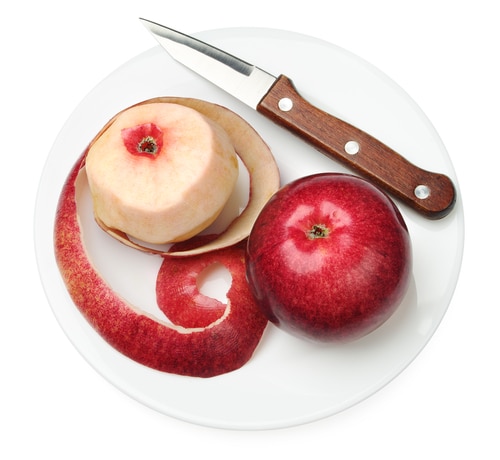
The Food and Drug Administration (FDA) recommends using running water as the best way to clean produce. Soaps, commercial produce washes, and detergents are sometimes chosen as proper ways to clean fruit and vegetables, but the FDA suggests that they may leave harmful ingredients on the peel. A healthy meal includes three times as much produce as meat so that three-quarters of a plate is covered with plant food. Carrots, nectarines, garlic, kiwis, and zucchini provide five reasons to eat the peel for good health.
Getting the Most from a Carrot
A soft scrub brush under running water cleans a carrot without removing the skin, the part that contains the most carotene, vitamins, and minerals. Packaged baby carrots, slices and shredded varieties deprive consumers of valuable nutrients, making the choice of the vegetable with greens attached the superior one. The bright orange color reveals the high content of beta-carotene, and the vegetable is an excellent source of potassium, magnesium, folic acid, thiamine, vitamin B6, and C. Carrots are more nutritious when cooked whole.
Choosing a Peach’s Sophisticated Cousin
The deep purple glow of a nectarine is nature’s way of attracting consumers, and vital nutrients are contained in its skin. The flesh of the fruit is similar to that of a peach, but it contains twice the amount of vitamin A and C, along with an abundance of potassium, phosphorous, iron and a significant amount of vitamin K, folic acid and magnesium. A slightly tart taste beneath the skin presents a delicious contrast to the sweet flesh of the fruit.
Shedding a Kiwi’s Fuzz
A brisk rub of a kiwi’s skin removes the fuzz without removing the nutritional Omega-3 fatty acids and alpha-linolenic acids that contribute to joint and heart health. Oranges contain a lesser concentration of vitamin C than kiwis, and the soft skin is entirely edible. The seeds that are abundant in the strange looking fruit contain significant nutrients and antioxidants as well, and they are excellent sources of fiber.
Enjoying the Versatile Zucchini
The taste of the zucchini skin is indistinguishable from the flesh, and it is rich in a range of nutrients that include vitamins A, C, and E, potassium and iron, magnesium and phosphate, beta-carotene, and zinc. The concentration of vitamin C in one cup of zucchini provides nearly 30 percent of the recommended daily requirement. Delicious when baked, stewed, fried, roasted or served raw with the skin on, zucchini is a versatile vegetable that is high in fiber and low in calories.
Savoring the Garlic
Upscale kitchen stores offer flexible tubes that are handy for removing the skin of the garlic, but merchants may not know that the peel contains nutrients that protect the heart and combat the aging process. Reports from the Royal Society of Medicine cite Japanese research that points to six antioxidant compounds in garlic skin. Removing the skin by crushing or cutting the clove removes antioxidants that make the pungent and flavorful garlic a valuable addition to health.
Putting away the vegetable peeler is a good start for increasing the amount of nutrition that is available in plant foods. The vibrant colors of fruits and vegetables act like clues from nature that the peel may be the best part. Eating the skin of garlic, nectarines, zucchinis, kiwis, carrots, and many other fruit and vegetables add fiber, flavor, and nutrients to a healthy diet.
Related Articles By Cathe:
6 Nutritional Hacks to Get More Nutrients from the Food You Eat
6 Ways to Get More Health and Nutritional Benefits from Fruits and Vegetables
Why Whole Foods Are Better Than Supplements
Eating Healthy: What Are the Pros and Cons of Juicing?

